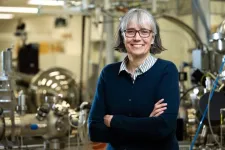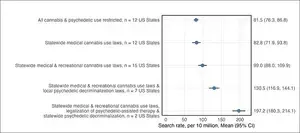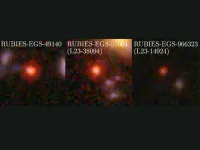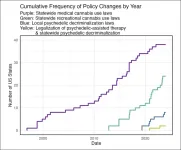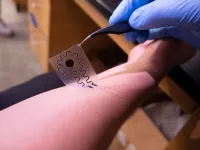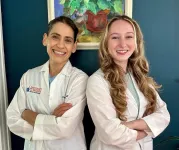(Press-News.org) UPTON, N.Y. — Elke Arenholz, a renowned scientist known for her expertise in magnetic materials and X-ray spectroscopy, scattering, imaging, and instrument development, has been named director of the National Synchrotron Light Source II (NSLS-II), a U.S. Department of Energy (DOE) Office of Science user facility at DOE’s Brookhaven National Laboratory, effective August 2024.
Arenholz’s appointment comes following a search that began in summer 2023 after John Hill, the previous director of NSLS-II, was named Brookhaven Lab's deputy director for science and technology. During this transition, Erik Johnson, deputy director for construction and manager of the Project Management group at NSLS-II, graciously took on the responsibilities of interim director. Johnson has played a major role in the design and planning of NSLS-II and its current operations.
“We are excited to have Elke join us as the next director of NSLS-II,” exclaimed Brookhaven Lab Director JoAnne Hewett. “Elke’s scientific accomplishments and management experience will provide the backdrop to enable the vision to lead NSLS-II into the next era. I thank Erik Johnson with sincere gratitude for the outstanding leadership he has shown during this transition.”
As one of the most advanced synchrotron light sources in the world, NSLS-II enables its growing research community to study materials with nanoscale resolution and exquisite sensitivity by providing cutting-edge capabilities. Together with visiting researchers from all around the world, interdisciplinary teams at NSLS-II uncover the atomic structure, elemental makeup, and electronic behavior of materials. Research at NSLS-II covers a wide range of scientific disciplines such as life sciences, quantum materials, energy storage, advanced materials science, physics, chemistry, and biology.
As NSLS-II director, Arenholz will lead a team of about 350 staff, including scientists, engineers, technicians, and professionals in several fields. While maintaining and improving the 29 beamlines that are currently in operation and keeping them competitive for a growing user community, she will also be instrumental in completing the construction of the three new NSLS-II Experimental Tools II project beamlines and embarking on the next generation of beamlines being designed as part of the NSLS-II Experimental Tools III project. Arenholz will work closely with the accelerator division to fulfill their current mission to deliver a performance of 500 milliamps for user operations before planning starts for a highly anticipated accelerator upgrade.
“Throughout my career, I have always felt a close connection to synchrotron facilities. I believe that they offer a very impactful way to do science,” said Arenholz. “NSLS-II is a state-of-the-art synchrotron that offers visiting researchers specialized tools and opportunities for unique collaborations with NSLS-II scientists and others. I am looking forward to contributing to the incredible work being done there, to supporting the synchrotron community and the broader scientific community in this new role.”
A passion for synchrotron science
Arenholz comes to Brookhaven from DOE’s Pacific Northwest National Laboratory, where she was director of the Physical Sciences Division. In that role, she led a large, diverse scientific portfolio, encompassing fields like catalysis, chemical physics, geochemistry, and materials science. Prior to the division director role, Arenholz co-led the Interconnected Science Ecosystem initiative at DOE’s Oak Ridge National Laboratory, where she developed computational and experimental capabilities to enable autonomous experimentation.
Throughout her career, Arenholz has amassed a wide range of experience in synchrotron science and management. She held the position of associate director at the Cornell High Energy Synchrotron Source (CHESS), where she helped the facility adapt to remote experiments during the COVID-19 pandemic. Prior to her role at CHESS, Arenholz held several positions at the Advanced Light Source (ALS), a DOE Office of Science user facility at DOE’s Lawrence Berkeley National Laboratory, starting as a postdoctoral research fellow and reaching the position of photon sciences operation group deputy. She described her research at ALS as “very hands-on,” covering a range of techniques that included spectroscopy, scattering, imaging, and time dependent studies.
“The first time I was able to work in a synchrotron facility was during my Ph.D. in Germany, and I fell in love with it,” remarked Arenholz. “I was impressed by the unique experimental capabilities these facilities offer scientists and the productive interactions and collaborations that happen within the diverse light source community. This includes everyone: the team in the user’s office, tradespeople, technicians, engineers, scientists, and so many others who are instrumental in facilitating the powerful discoveries that happen at these facilities.”
With a career spanning over 400 publications, Arenholz has delved into the diverse aspects of magnetism and magnetic materials, magnetization dynamics and applications in spintronics, quantum phenomena, and the characterization of novel materials and their potential applications. She has vast interest and experience in X-ray spectroscopy, resonant X-ray scattering, X-ray microscopy, and the development of new instruments for X-ray characterization. While she is eager to explore the scientific research and technical work being done at NSLS-II, she is also eager to learn more about the staff community and its culture.
“I’m excited to get to know everyone, because it’s really all about the people,” said Arenholz. “We interface with visiting researchers, we interface with each other, and those interactions drive what we do. I want everyone at NSLS-II to know that they are making a meaningful contribution to something big. I’m looking forward to learning what everyone is working on and how I can help them.”
In 2024, Arenholz was named a fellow of the Institute of Electrical and Electronics Engineers for her contributions to X-ray magnetic spectroscopy. In 2014, she was named a fellow of the American Physical Society. At ALS, she was presented with the Klaus Halbach Award for Innovative Instrumentation for the design and implementation of a versatile vector magnetometer for soft X-ray studies in 2005 and the Tim Renner Award for untiring efforts in the assistance of users in generating high profile research results with the elliptically polarizing undulator in 2001. She is very active in the scientific community, serving on several proposal review panels, scientific and technical advisory committees, and conference organizing committees. She is also the editor-in-chief and founding editor of the journal npj Spintronics.
Arenholz earned her Ph.D. in physics, summa cum laude, from the Freie Universität Berlin, Germany. She earned her bachelor’s and master’s degrees in condensed matter physics from the University of Regensburg, Germany.
Brookhaven National Laboratory is supported by the Office of Science of the U.S. Department of Energy. The Office of Science is the single largest supporter of basic research in the physical sciences in the United States and is working to address some of the most pressing challenges of our time. For more information, visit science.energy.gov.
Follow @BrookhavenLab on social media. Find us on Instagram, LinkedIn, Twitter, and Facebook.
END
Elke Arenholz named director of the National Synchrotron Light Source II at Brookhaven Lab
2024-06-28
ELSE PRESS RELEASES FROM THIS DATE:
Tiny bright objects discovered at dawn of universe baffle scientists
2024-06-28
UNIVERSITY PARK, Pa. — A recent discovery by NASA’s James Webb Space Telescope (JWST) confirmed that luminous, very red objects previously detected in the early universe upend conventional thinking about the origins and evolution of galaxies and their supermassive black holes.
An international team, led by Penn State researchers, using the NIRSpec instrument aboard JWST as part of the RUBIES survey identified three mysterious objects in the early universe, about 600-800 million years after the Big Bang, ...
Study shows corporate social misbehavior hurts brands
2024-06-28
In today's interconnected world, the actions of corporations can have far-reaching consequences. A new study, co-authored by two University of Akron (UA) faculty and published in the top ranked international business journal Global Strategy Journal, reveals that incident of corporate social irresponsibility (CSI) — like pollution, corruption, discrimination, or poor labor conditions in supply chains — significantly damage brand reputation and international sales growth.
Over nine years and across 109 countries, researchers tracked the performance of 335 company branches alongside reported CSI incidents involving their parent companies. The results clearly ...
Creating supranormal hearing in mice
2024-06-28
A study from Michigan Medicine's Kresge Hearing Research Institute was able to produce supranormal hearing in mice, while also supporting a hypothesis on the cause of hidden hearing loss in humans.
The researchers had previously used similar methods—increasing the amount of the neurotrophic factor neurotrophin-3 in the inner ear—to promote the recovery of auditory responses in mice that had experienced acoustic trauma, and to improve hearing in middle-aged mice.
This study is the first to use the same approach in otherwise healthy young mice to ...
Most Americans don’t know that primary care physicians can prescribe addiction treatment
2024-06-28
Results from a national survey indicate that many Americans, 61%, are unaware that primary care physicians can prescribe medications for opioid use disorder, and 13% incorrectly believed that they could not. The survey, funded by the National Institutes of Health (NIH), also found that 82% of the people who reported ever misusing prescription or illicit opioids expressed comfort in going to their primary care physicians for medications for opioid use disorder. Among those who had not misused opioids, a majority, 74%, reported they would ...
Heritability of body mass index among familial generations
2024-06-28
About The Study: In this study, the weight status of parents at 17 years of age was associated with obesity risk for both female and male offspring, emphasizing that parental factors may influence the next generation’s health outcomes.
Corresponding Author: To contact the corresponding author, Gabriel Chodick, Ph.D., email chodick@tauex.tau.ac.il.
To access the embargoed study: Visit our For The Media website at this link https://media.jamanetwork.com/
(doi:10.1001/jamanetworkopen.2024.19029)
Editor’s Note: Please ...
Source-specific air pollution and loss of independence in older adults across the US
2024-06-28
About The Study: This study found that long-term exposure to air pollution was associated with the need for help for lost independence in later life, with especially large and consistent increases in risk for pollution generated by traffic-related sources. These findings suggest that controlling air pollution could be associated with diversion or delay of the need for care and prolonged ability to live independently.
Corresponding Author: To contact the corresponding author, Boya Zhang, Ph.D., email zhboya@umich.edu.
To ...
As restrictions on cannabis and psychedelics ease, Americans dabble with ‘microdosing’
2024-06-28
Loosening local, state and federal regulations on cannabis and psychedelics has increased Americans' interest in microdosing, according to a study from researchers at the University of California San Diego. Published in JAMA Health Forum, the study found that the rate of microdosing-related Google searches grew by 1250% from 2015 to 2023, with over three million searches in 2023 alone. This surge in interest correlates with recent legislative changes decriminalizing or authorizing the use of psychedelic substances in therapy and permitting ...
Soft, stretchy electrode simulates touch sensations using electrical signals
2024-06-28
A team of researchers led by the University of California San Diego has developed a soft, stretchy electronic device capable of simulating the feeling of pressure or vibration when worn on the skin. This device, reported in a paper published in Science Robotics, represents a step towards creating haptic technologies that can reproduce a more varied and realistic range of touch sensations.
The device consists of a soft, stretchable electrode attached to a silicone patch. It can be worn like a sticker ...
Undergrad's Crohn's discovery could lead to better treatments for devastating condition
2024-06-28
Remarkable new research by a University of Virginia undergraduate may help explain recurrent Crohn’s disease in children and open the door to new ways to treat or even cure the devastating condition.
Crohn’s is a debilitating – and possibly life-threatening – inflammation of the digestive tract. Symptoms include abdominal pain, weakness, fatigue and malnutrition caused by the body’s inability to absorb nutrients. It’s most common in adults but afflicts tens of thousands of children in the United States alone. Many of those ...
Pilot study shows promise for remote cognitive rehabilitation for multiple sclerosis
2024-06-28
East Hanover, NJ – June 28, 2024 – A pilot study shows promise for a new treatment option for individuals with memory impairments caused by multiple sclerosis (MS). The article, “Exploring the efficacy of a remote strategy-based intervention for people with multiple sclerosis with everyday memory impairments: A pilot study,” (doi: 10.5014/ajot.2024.050468) was published online on May 27, 2024, in the American Journal of Occupational Therapy.
This proof-of-concept study, conducted in ten participants ...
